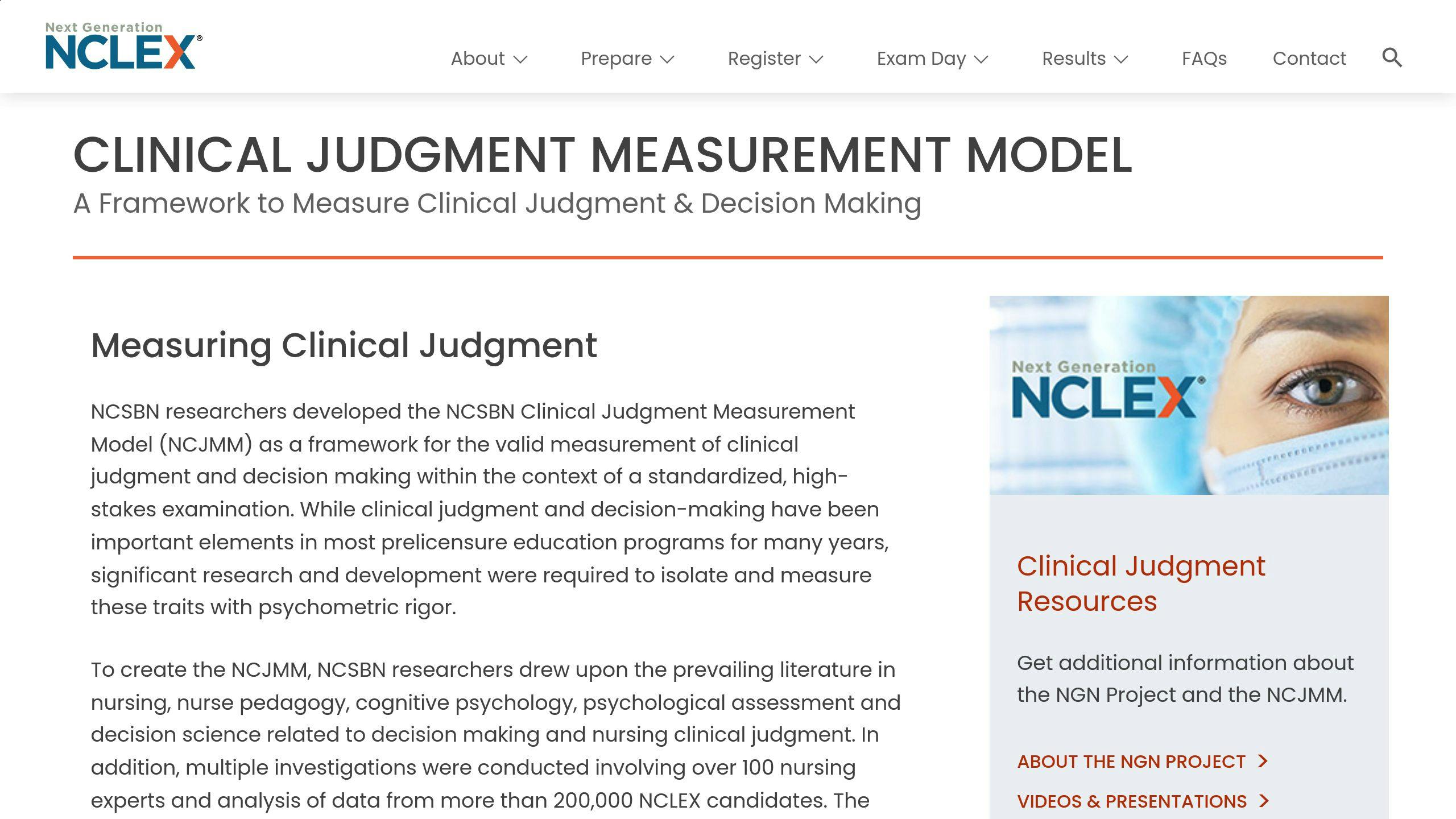Want to ace the Next Generation NCLEX (NGN)? Start by mastering clinical cues – key patient details like vital signs, symptoms, and behaviors that guide nursing decisions. This article breaks down how to identify, analyze, and prioritize these cues using the NCSBN Clinical Judgment Model.
Key Takeaways:
- Clinical Cues Matter: Learn to spot patterns in breathing, vitals, and behaviors to make critical care decisions.
- NCSBN Model: Follow six steps – Recognize, Analyze, Prioritize, Generate, Act, and Evaluate – to tackle NGN case studies effectively.
- Practice for Success: Use tools like NurseCram to sharpen your skills with realistic scenarios.
Ready to improve your clinical judgment? Let’s dive into how clinical cues apply to NGN and everyday nursing.
NCLEX NGN Case Study Breakdown: Clinical Judgement Measurement Model Layer 3
What Are Clinical Cues and Why Are They Important?
Understanding clinical cues is a key part of making informed decisions in nursing. These cues are specific signs or indicators about a patient’s condition that help guide nursing actions. For both nursing practice and the NGN exam, they play a critical role in building strong clinical judgment [5][6].
How Clinical Cues Are Used in the NGN Exam
The Next Generation NCLEX (NGN) integrates clinical cues using realistic case studies. These case studies provide detailed patient information that candidates must analyze and interpret. The exam focuses on a nurse’s ability to:
| Clinical Cue Assessment | Purpose in NGN |
|---|---|
| Recognition | Spot important patient details and changes |
| Analysis | Evaluate the meaning of observed cues |
| Prioritization | Determine which cues are most critical for care |
| Decision-Making | Develop nursing interventions based on these cues |
The NCSBN describes recognizing cues as the skill of interpreting and assessing their importance in clinical situations. These abilities are best understood through practical examples of how cues appear in real-life scenarios.
Examples of Clinical Cues in Patient Scenarios
Clinical cues come from various areas, including patient observations, medical data, and environmental factors. Here’s how they show up in different aspects of care:
| Category | Examples of Clinical Cues |
|---|---|
| Environmental Cues | Room temperature, lighting conditions |
| Client Observation | Breathing patterns, skin tone, level of alertness |
| Medical Record Data | Vital signs, lab results, medication history |
| Time-Related Cues | Changes in condition or timing of interventions |
For instance, clinical cues can include:
- Objective Data: Elevated respiratory rate, low oxygen saturation levels
- Subjective Information: Patient reports of trouble breathing when lying down
- Observable Behaviors: Use of accessory muscles for breathing, preference for upright positioning [3]
Interpreting these cues is a cornerstone of both NGN preparation and effective nursing care [5][6].
Using the NCSBN Clinical Judgment Model in NGN Case Studies

The NCSBN Clinical Judgment Measurement Model offers a structured approach for analyzing NGN case studies. It helps nurses build their clinical judgment and decision-making skills in a systematic way. This model aligns with the NGN exam’s focus on clinical judgment, giving candidates a clear method for tackling challenging patient scenarios.
Steps in the Clinical Judgment Model
This model breaks the decision-making process into six steps, each with a specific purpose:
| Step | Purpose | Application in Case Studies |
|---|---|---|
| Recognize Cues | Identify relevant patient information | Spot key symptoms and data |
| Analyze Cues | Understand the meaning of observed data | Connect symptoms to potential issues |
| Prioritize Hypotheses | Identify the most likely scenarios | Rank diagnoses by urgency |
| Generate Solutions | Develop potential interventions | Plan care strategies |
| Take Actions | Implement chosen interventions | Carry out nursing actions |
| Evaluate Outcomes | Assess intervention results | Review patient improvement |
How NGN Case Studies Use This Model
NGN case studies simulate real-life clinical situations while incorporating the steps of the Clinical Judgment Model. This allows nurses to practice a structured approach to decision-making.
"Analyzing cues involves evaluating client data within the broader clinical scenario to determine their significance" (NCSBN, 2019) [6]
For example, consider a patient experiencing shortness of breath with a history of heart disease. Nurses must decide whether the issue stems from heart failure, pneumonia, or another condition by analyzing symptoms and vital signs. Here’s how the model is applied:
- Recognition Phase: Nurses identify critical symptoms (e.g., shortness of breath) and relevant history, such as cardiovascular risk factors.
- Analysis and Prioritization: They evaluate whether the symptoms align more with heart failure or another condition.
- Solution Generation and Action: Based on the analysis, nurses develop and implement appropriate care strategies tailored to the patient’s needs.
This structured approach ensures nurses can handle complex scenarios by carefully considering all clinical cues [1][3]. Mastering these steps not only improves clinical judgment but also prepares nurses for the next section’s strategies to refine this skill further.
sbb-itb-aa73634
Tips for Identifying and Interpreting Clinical Cues in NGN Case Studies
How to Group and Prioritize Clinical Cues
When analyzing case studies, organize clinical cues into categories such as environmental factors (e.g., room conditions), client observations (e.g., vital signs or behaviors), medical data (e.g., lab results), and time-sensitive factors (e.g., acute changes). Focus on the most urgent cues first – those that directly impact the patient’s current condition. For example, in cases of respiratory distress, oxygen levels and breathing patterns should take priority over less immediate concerns like routine lab results [5].
| Cue Type | Examples | Priority |
|---|---|---|
| Environmental | Room conditions, equipment status | Low |
| Client Observations | Vital signs, symptoms, behaviors | High |
| Medical Record Data | History, lab results, medications | Medium |
| Time-Sensitive Factors | Acute changes, deterioration signs | Urgent |
Finding Patterns in Patient Information
Spotting patterns means identifying unexpected findings – data that doesn’t align with what you’d expect – and connecting related symptoms. For example, a heart failure patient presenting with fever and a productive cough could indicate a secondary respiratory infection that needs immediate attention. Similarly, shortness of breath, swollen ankles, and fatigue together might signal worsening heart failure [3][5].
Using Practice Tools to Build Skills
Tools like NurseCram offer NGN-style case studies, detailed rationales, and exercises that help refine clinical judgment. These resources are designed to mimic NCLEX scenarios and are particularly useful for practicing complex cases. Focus your practice on tasks such as:
- Identifying key symptoms and vital signs
- Linking the patient’s history to their current condition
- Recognizing findings that demand immediate action
- Creating intervention plans based on observed patterns
These strategies not only prepare you for NGN exams but also sharpen your ability to make informed decisions in real-world nursing situations, where clinical cues are the foundation of patient care.
How Clinical Cues Apply to Everyday Nursing
Clinical cues play a central role in nursing, shaping decisions that directly impact patient care and safety [7][4]. Recognizing and prioritizing these cues in NGN case studies reflects the real-world critical thinking nurses use every day.
Using Clinical Cues to Create Care Plans
Developing care plans requires nurses to piece together multiple clinical cues to fully understand a patient’s condition. This involves analyzing both clear and subtle signs that could influence treatment. For instance, in a cardiac unit, cues like shortness of breath, difficulty breathing while lying down, and activity intolerance help nurses design targeted interventions [3].
| Care Plan Component | Role of Clinical Cues |
|---|---|
| Assessment & Diagnosis | Vital signs, symptoms, and test results help identify patient needs and guide treatment choices. |
| Implementation | Monitoring responses to treatments and addressing complications ensures effective care delivery. |
| Evaluation | Progress updates and patient feedback inform necessary adjustments to the care plan. |
While care plans provide structure, real-time monitoring is essential for addressing new clinical cues as they arise.
Responding to New Clinical Cues During Care
Nurses must stay vigilant for new clinical cues that indicate changes in a patient’s condition. In post-surgical care, specific cues require close attention:
- Physiological changes: Shifts in vital signs or unexpected pain patterns
- Behavioral signs: Alterations in appetite or social interactions
- Emotional signals: Emerging anxiety or withdrawal
Spotting these cues early allows for timely interventions, reducing complications and improving outcomes [7][4].
To integrate cue recognition into daily practice, nurses should adopt a systematic approach to patient assessment. This includes tracking vitals, actively communicating with patients, and noting subtle changes. The goal is to stay ahead of potential issues, using clinical judgment to address them before they escalate [7].
Building these skills not only improves patient care but also prepares nurses for the NGN exam’s focus on clinical judgment.
Conclusion: Practice Clinical Cues to Succeed in the NGN Exam
Mastering the NGN exam requires regular practice in recognizing and interpreting clinical cues. This involves honing your ability to spot patterns, prioritize urgent information, and connect physical, behavioral, and emotional signs effectively [1][3].
Here are some tips to sharpen your clinical judgment:
-
Use a Structured Approach
Follow the NCSBN Clinical Judgment Model to systematically analyze clinical scenarios. Practice linking multiple cues to create a complete clinical picture and design interventions based on evidence [5][6]. -
Work on Complex Cases
Tackle scenarios with interconnected symptoms. For instance, connect chest pain with anxiety or other indirect indicators. Practice explaining your reasoning behind each decision [3]. -
Leverage Practice Tools
Platforms like NurseCram offer scenario-based exercises with detailed explanations. These tools can help you:
Developing strong clinical cue recognition skills is key not only for acing the NGN exam but also for excelling in nursing practice. Regular practice with realistic cases and a systematic approach will prepare you for both the test and delivering high-quality patient care [7].
FAQs
How to answer case study in NCLEX?
The Next Generation NCLEX (NGN) case studies require a clear, step-by-step analysis based on the NCSBN Clinical Judgment Model. Here’s a practical method to approach them:
| Step | Action | Example |
|---|---|---|
| 1. Read Carefully | Review all the provided case details | Patient history, symptoms, and vital signs |
| 2. Identify Key Cues | Pinpoint critical clinical data | Abnormal vital signs, key symptoms |
| 3. Analyze & Connect | Relate findings to identify patterns | Group symptoms, recognize trends |
| 4. Prioritize | Focus on the most pressing issues | Address immediate safety risks, critical changes |
| 5. Plan Response | Choose the best interventions | Evidence-based actions, ensure patient safety |
Let’s break it down with an example:
A 78-year-old patient arrives with:
- Shortness of breath
- Fever of 101.2°F
- Productive cough producing green sputum
How to approach:
- Gather Facts: Take note of the patient’s age, symptoms, and vital signs.
- Connect Information: Link respiratory symptoms to the fever.
- Prioritize Concerns: Focus first on addressing breathing issues.
- Plan Care: Decide on interventions, such as oxygen support or further diagnostic tests.
"Early detection of health deterioration through clinical cues allows for timely intervention, reducing the risk of complications and improving patient outcomes" [2][4].
Platforms like NurseCram provide practice exercises tailored for NGN case studies. These tools include detailed explanations of the clinical judgment process, helping you refine your analytical skills [1][3].
Related posts
- NGN NCLEX Scenario Exercises: Step-by-Step Practice
- NGN Case Study Question Types Explained
- Top 7 Clinical Cues to Watch for in NGN Scenarios
- Prioritization and Delegation: Case Study Examples

Mia is dedicated to helping nursing students and new graduates confidently prepare for the Next Generation NCLEX exam. With a focus on providing clear, actionable advice and support, Mia offers practical study tips, effective strategies, and encouragement to guide you through the complexities of nursing exams. Whether you need help mastering question formats, managing stress, or creating a personalized study plan, Mia is here to ensure you feel prepared and empowered every step of the way.

